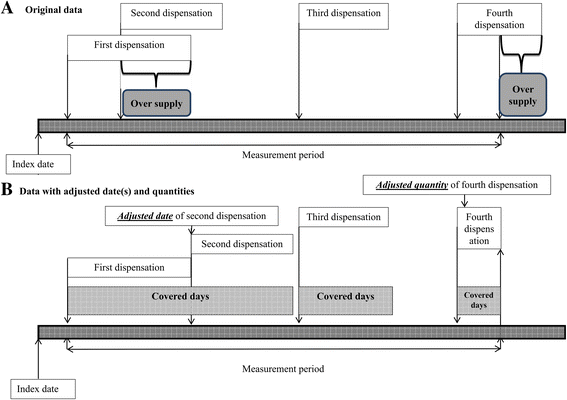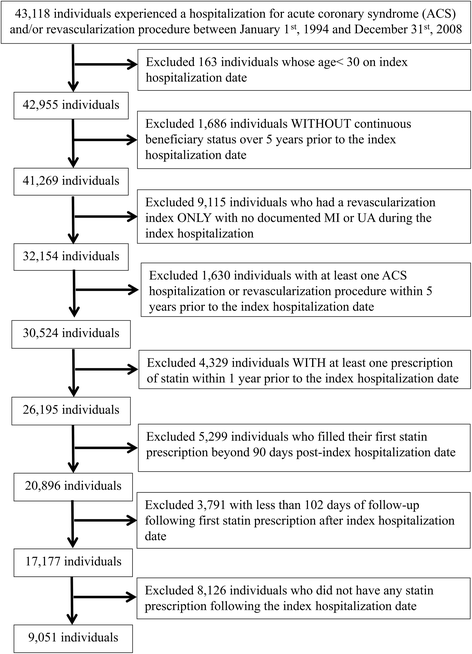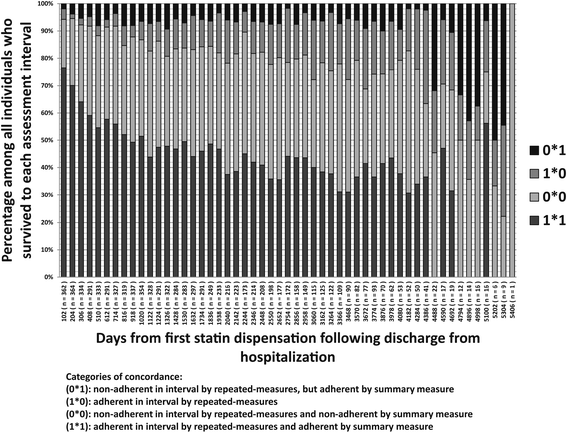Does the association between adherence to statin medications and mortality depend on measurement approach? A retrospective cohort study
- PMID: 28427340
- PMCID: PMC5397806
- DOI: 10.1186/s12874-017-0339-z
Does the association between adherence to statin medications and mortality depend on measurement approach? A retrospective cohort study
Abstract
Background: The aim of this study was to examine the relationship between mortality and statin adherence using two different approaches to adherence measurement (summary versus repeated-measures).
Methods: A retrospective cohort study was conducted using administrative data from Saskatchewan, Canada between 1994 and 2008. Eligible individuals received a prescription for a statin following hospitalization for acute coronary syndrome (ACS). Adherence was measured using proportion of days covered (PDC) expressed either as: 1) a fixed summary measure, or 2) as a repeatedly measured covariate. Multivariable Cox-proportional hazards models were used to estimate the association between adherence and mortality.
Results: Among 9,051 individuals, optimal adherence (≥80%) modeled with a fixed summary measure was not associated with mortality benefits (adjusted HR 0.97, 95% CI 0.86 to 1.09, p = 0.60). In contrast, repeated-measures approach resulted in a significant 25% reduction in the risk of death (adjusted HR 0.75, 95% CI 0.67 to 0.85, p < 0.01).
Conclusions: Unlike the summary measure, the repeated measures approach produces a significant reduction of all-cause mortality with optimal adherence. This effect may be a result of the repeated measures approach being more sensitive, or more prone to survival bias. Our findings clearly demonstrate the need to undertake (and report) multiple approaches when assessing the benefits of medication adherence.
Keywords: Compliance/adherence; Lipids and cholesterol; Mortality; Secondary prevention; Treatment.
Figures




Similar articles
-
Adherence to statin treatment and health outcomes in an Italian cohort of newly treated patients: results from an administrative database analysis.Clin Ther. 2012 Jan;34(1):190-9. doi: 10.1016/j.clinthera.2011.12.011. Clin Ther. 2012. PMID: 22284998
-
Results of a retrospective database analysis of adherence to statin therapy and risk of nonfatal ischemic heart disease in daily clinical practice in Italy.Clin Ther. 2010 Feb;32(2):300-10. doi: 10.1016/j.clinthera.2010.02.004. Clin Ther. 2010. PMID: 20206788
-
Impact of Statin Adherence on Cardiovascular Morbidity and All-Cause Mortality in the Primary Prevention of Cardiovascular Disease: A Population-Based Cohort Study in Finland.Value Health. 2015 Sep;18(6):896-905. doi: 10.1016/j.jval.2015.06.002. Epub 2015 Aug 5. Value Health. 2015. PMID: 26409618
-
Community Pharmacy-Based Inducement Programs Associated With Better Medication Adherence: A Cohort Study.Ann Pharmacother. 2017 Aug;51(8):630-639. doi: 10.1177/1060028017703720. Epub 2017 Apr 3. Ann Pharmacother. 2017. PMID: 28372491
-
Very early initiation of statin therapy and mortality in patients with acute coronary syndrome.Acute Card Care. 2012 Mar;14(1):34-9. doi: 10.3109/17482941.2012.655297. Epub 2012 Feb 1. Acute Card Care. 2012. PMID: 22295883 Review.
Cited by
-
Antipsychotic treatment adherence and motor vehicle crash among drivers with schizophrenia: a case-crossover study.CMAJ. 2025 Jun 8;197(22):E612-E619. doi: 10.1503/cmaj.250020. CMAJ. 2025. PMID: 40490284 Free PMC article.
-
Impact of time-varying cumulative bevacizumab exposures on survival: re-analysis of data from randomized clinical trial in patients with metastatic colo-rectal cancer.BMC Med Res Methodol. 2021 Jan 9;21(1):14. doi: 10.1186/s12874-020-01202-9. BMC Med Res Methodol. 2021. PMID: 33422006 Free PMC article. Clinical Trial.
-
Methods and validity indicators for measuring adherence to statins in secondary cardiovascular prevention: a systematic review.Syst Rev. 2025 May 15;14(1):110. doi: 10.1186/s13643-025-02853-9. Syst Rev. 2025. PMID: 40375350 Free PMC article.
-
Methods and validity indicators for measuring adherence and persistence to aspirin in secondary cardiovascular prevention: a systematic review.Front Cardiovasc Med. 2025 May 26;12:1570331. doi: 10.3389/fcvm.2025.1570331. eCollection 2025. Front Cardiovasc Med. 2025. PMID: 40491717 Free PMC article.
-
Low adherence to statin treatment during the 1st year after an acute myocardial infarction is associated with increased 2nd-year mortality risk-an inverse probability of treatment weighted study on 54 872 patients.Eur Heart J Cardiovasc Pharmacother. 2021 Mar 15;7(2):141-147. doi: 10.1093/ehjcvp/pvaa010. Eur Heart J Cardiovasc Pharmacother. 2021. PMID: 32058542 Free PMC article.
References
Publication types
MeSH terms
Substances
LinkOut - more resources
Full Text Sources
Other Literature Sources
Medical

